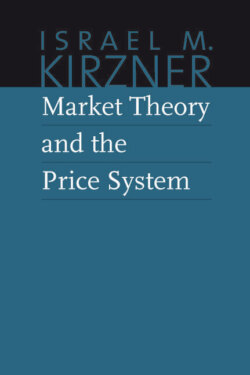Читать книгу Market Theory and the Price System - Israel M. Kirzner - Страница 28
На сайте Литреса книга снята с продажи.
THE CHANGING MARKET
ОглавлениеMuch of our discussion thus far has concerned the attitudes of individuals at a given point in time, or over a period during which these attitudes are assumed not to change. The analysis of the market under these artificial conditions makes it possible, in addition, to grasp the course of the market process as it would operate in the absence of these restrictive assumptions. Let us consider again the pattern of adjustment discussed in the previous section.
If we permit change to occur in the urgency with which prospective buyers are anxious to acquire the commodity sold in the market, or if we permit change to occur in the conditions governing the production and supply of the commodity to the market, a number of new elements enter into the situation. It is clear, first of all, that with respect to the attitudes of buyers and sellers toward the commodity as of each moment, a different equilibrium situation occurs toward which the market would tend if the attitudes of that moment were maintained indefinitely. Since attitudes are permitted to change, it follows that the market process, the ceaseless agitation of the market, is being continually pulled toward a different equilibrium position. Would-be buyers and sellers who were disappointed in their past market activity—or who, even if not disappointed in the past, do not wish to be disappointed in the future—must revise their bids or offers to make them more attractive to the current market. A quite different importance is now attached to the skill of anticipating future market conditions. Disappointment of plans made by would-be sellers will spur them to undertake production only by their assessment of future demand conditions.
But the basic pattern of market adjustment is applicable in this changing market as well. The disappointments engendered at any one time by the existing absence of equilibrium will help to guide subsequent plans to anticipate the correct future conditions. Since the changes in market data can be expected to proceed only gradually, the success or failure of past plans can provide a fairly reliable indicator of how these plans must be revised in the future. Thus, market forces are still able to direct the agitation of the market in the direction of a uniform market price, and of a correspondence between the quantities offered and demanded in the market at given prices.
Where a considerable change in the basic market attitudes has occurred with abruptness, the consequences are not difficult to understand. The change will make itself felt initially by severely disappointing the plans of buyers and sellers who had been unable to foresee the change. If, for example, the supply of the commodity has been abruptly halted by the sudden unavailability of a vital raw material, then many buyers will find that the price they had confidently expected to obtain the commodity at is no longer in effect. If, to take a different possibility, the emergence of some new product abruptly reduces the dependency of consumers upon the commodity we are considering, then sellers will find that their offers to sell will no longer be accepted at the old prices. In short, any kind of abrupt change will immediately increase the degree of disequilibrium existing in the market, and will therefore initiate fairly rapid and extensive adjustments in the plans of buyers and sellers in the direction of the state of equilibrium corresponding to the new state of affairs.
